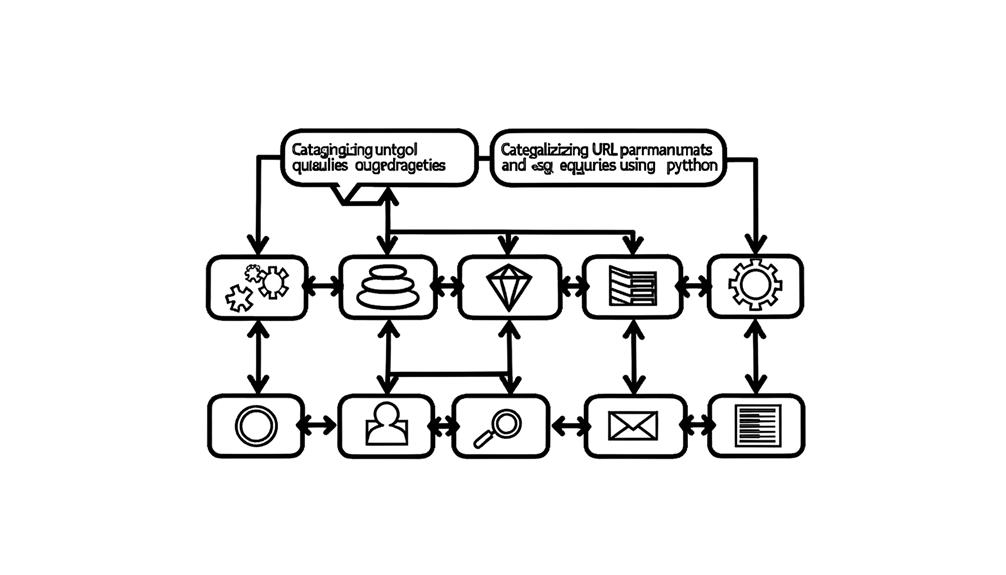We use Python's libraries like urllib to extract and categorize URL parameters and queries, crucial for SEO analysis. We sort and style the data using tools like pandas. Interactive visualizations, created by matplotlib, help us identify patterns and correlations, narrating the story within our data. Our SEO optimization relies on refining URLs through elimination of unnecessary parameters, thus improving our sites' visibility and user experience. Understanding this process fully opens up a world of insightful analysis, paving the way to bolster your SEO strategies efficiently. Join us further to unfold greater depths of URL parameter categorization.
Key Takeaways
- Utilize Python's advertools' crawl function for URL collection and the URLLib's parse_qs function for parameter manipulation.
- Organize URLs and their parameters into structured formats using Pandas Data Frames for efficient analysis and SEO optimization.
- Use Python's urllib to extract and analyze URL queries, providing insights into user behavior and aiding in refining SEO strategies.
- Create interactive visualizations using Python libraries like matplotlib and Plotly, to identify patterns and correlations between different URL components for improved SEO.
- Regularly analyze and eliminate unnecessary parameters and queries, optimizing the website's URL structure, enhancing SEO visibility, and improving user experience.
Understanding URL Parameter Analysis
Diving into the world of URL parameter analysis, we first utilize the advertools Crawl Function to collect a wide spectrum of URLs for our Python-based investigation. This Python tool lays the groundwork for our main task: URL parameter categorization. By diligently dissecting URLs, we're able to identify and classify parameters. This categorization is not just a mere analytical exercise. It carries significant SEO impact. A well-structured URL, with properly categorized parameters, boosts our website's visibility and performance. It leads to a more efficient crawl by search engines and enhances the user experience, thereby having a positive effect on SEO. In our quest for optimal SEO results, we're harnessing the power of Python tools for URL analysis, demonstrating their efficacy in unveiling crucial insights.
Parsing and Visualizing URL Parameters
Having understood the pivotal role URL parameter analysis plays in SEO, we can now explore the process of parsing and visualizing these parameters using Python. We'll start by employing URLLib's parse_qs function, which conveniently turns URL parameters into a dictionary for easy manipulation. This step is fundamental for URL parameter categorization. Next, we showcase URL parameter visualization through Plotly, a library that creates interactive visualizations, helping us identify patterns and redundancies. By eliminating unnecessary parameters, we optimize our website structure, enhancing SEO. Remember, regular URL analysis is crucial for SEO health and efficiency. Thus, through Python, we can effectively transform URL parameter analysis into a powerful tool for SEO optimization.
Extracting and Analyzing URL Queries

Now, let's shift our focus to extracting and analyzing URL queries, another vital component in URL analysis that aids in further refining our SEO strategies. Efficient URL query extraction techniques come into play here, with Python's urllib being our tool of choice. By parsing the query section of a URL, we can categorize and analyze it, thereby gaining insights into website usage and user behavior. However, it's not just about extracting data; it's also about implementing query parameter optimization strategies. By eliminating irrelevant queries and focusing on those that add value, we streamline our SEO efforts, enhancing website crawl efficiency. Remember, a well-optimized URL structure is more than just aesthetically pleasing; it's a crucial determinant of your website's search engine ranking.
Creating and Styling Data Frames

After successfully extracting and optimizing our URL queries, let's turn our attention to organizing this data into structured formats using Pandas data frames. We'll leverage data frame manipulation techniques to sort our dictionaries based on key values. This ordered arrangement aids in more efficient analysis and interpretation of our data. After transformation into a data frame, we'll apply advanced styling techniques for better visibility and comprehension. Styling is not just about aesthetics, it's about making data more readable and meaningful. We'll use Python's URLLib module, following RFC 3986 conventions, to display our data in a formatted and visually appealing manner. This meticulous process will help us understand our URL's SEO performance in detail.
Visual Representation of URL Components

Let's dive into creating visual representations of our URL components, a crucial step that will give us a comprehensive understanding of our SEO data in a digestible format. By using Python libraries such as matplotlib or seaborn, we can craft interactive visualizations. These visual representations provide an immediate, intuitive overview of our URL component classification, making data analysis more efficient and insightful. We can create bar charts or pie charts to display the frequency of different parameters and queries in our URLs. Moreover, we can use heatmaps to reveal correlations between different components. These visual tools not only enhance our analysis but also serve as a foundation for data-driven SEO optimization strategies. Remember, a good visualization narrates the story behind the data.
Optimizing Website Structure for SEO

Having leveraged the power of visualizations to understand our URL components better, we can shift our attention towards fine-tuning the structure of our website to enhance SEO performance. This process involves two key aspects: website architecture and content optimization.
A well-planned website architecture ensures easier navigation, better user experience, and improved crawlability by search engines. Similarly, content optimization involves the strategic placement of keywords and the creation of high-quality, relevant content.
| Website Architecture | Content Optimization |
|---|---|
| Ensures easier navigation | Strategic placement of keywords |
| Improves user experience | Creation of high-quality, relevant content |
| Enhances search engine crawlability | Boosts organic SEO ranking |
Improving Website Crawl Efficiency

To enhance our website's crawl efficiency, we can leverage Python's power to eliminate superfluous URL parameters and streamline the structure. This is vital for improving our SEO performance and website indexing.
Here are the steps we'll follow:
- We'll use Python's urllib.parse to dissect our URLs, isolating queries and parameters.
- We'll analyze these components, identifying any that are redundant or irrelevant.
- Using this analysis, we'll strip out unnecessary parameters, creating a cleaner, more efficient URL structure.
- Finally, we'll monitor the impact of these changes on our SEO performance and website indexing, adjusting our approach as needed.
Enhancing SEO With URL Analysis

Regularly analyzing our URLs, specifically their queries and parameters, can significantly enhance our SEO by highlighting potential areas of optimization. By performing SEO keyword research, we can identify keywords that can be integrated within our URLs to improve visibility. This, in turn, boosts our SEO performance. Further, a backlink analysis can help us understand the number of external links pointing to our website. These backlinks are factored into search engine ranking algorithms and contribute to our site's authority. Using Python, we can efficiently categorize URL parameters and queries, making it easier to conduct our SEO keyword research and backlink analysis. Through Python's analytical power, we can dissect our URLs, identify areas of improvement, and consequently enhance our SEO strategy.
Frequently Asked Questions
How Does Pythons URLLIB Module Differ From Other URL Parsing Libraries?
We've compared urllib with other Python libraries and found that urllib's functionalities stand out in URL parsing. It efficiently breaks down URLs into components and excels in converting URL parameters into dictionaries for analysis. Unlike other libraries, urllib follows RFC 3986 standards. So, it's not just about parsing; urllib offers a more comprehensive, standardized approach to handle URLs, making it an excellent choice for SEO analysis.
Can Pythons Parse_Qs Function Handle URLS With Multiple Parameters?
Absolutely, Python's parse_qs function can handle URLs with multiple parameters. It decodes each parameter and stores them in a dictionary for easy access. This improves query strings' efficiency by allowing us to easily analyze and categorize each parameter. We're able to ensure our parameter encoding practices are up to standard, streamlining our data for SEO analysis. It's a powerful tool in our Python arsenal for website optimization.
What Are the Best Practices for Structuring URLS for Optimal Seo?
We've found that structuring URLs for optimal SEO involves strategic keyword placement and ensuring the URL length isn't excessively long. Keywords should be relevant and placed naturally within the URL to improve search engine rankings. Regarding URL length, shorter is often better for user experience and search visibility. Regular analysis of URLs, including parameters and queries, is essential to maintain effective SEO practices. Python's flexibility and robust libraries make it an excellent tool for this analysis.
How Often Should I Conduct URL Parameter and Query Analysis for Seo?
We recommend conducting URL parameter and query analysis for SEO periodically. The frequency depends on your site's complexity and updates. Regular analysis enables effective impact assessment, revealing potential issues before they affect your traffic. By monitoring traffic changes, we can adapt accordingly, optimizing our site's structure. Remember, staying proactive in SEO health checks, including URL analysis, is crucial to maintain a competitive edge.
What Other Python Libraries Can Be Used for SEO Analysis Besides Advertools?
We're big fans of Python's BeautifulSoup for SEO, as it's great for web scraping and parsing HTML. It's easy to use and incredibly powerful. We've also found the Scrapy library effective for large scale web crawling, data extraction, and handling requests. It's robust and versatile. Both libraries compliment advertools and enhance our SEO analysis by providing additional data and insights. We often use them in conjunction for more comprehensive results.



